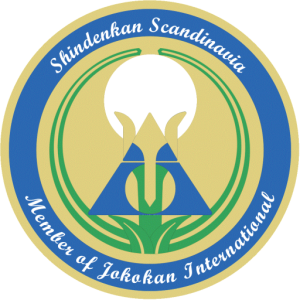By Pia Hornung, Shidoin, 2nd kyu Yakami Shinsei-ryu, 1st kyu Bujutsu Kodosoku-kai Jikitai Karate-do, 1st kyu Bujutsu Kodosoku-kai Gensei-ryu Karate-do
Hsingi, Chinese martial arts, is a course that has not been offered for several years, and the only course I need before TG4 graduation, so of course there was no doubt about my participation in the course in April 2019. Now there never is, which of course requires prioritization and planning, because I don't necessarily want to miss anything. In hindsight, there was no way I would have done without just a small part. Because there was quality in the course, all the way through. Kimu Sensei, who has a grandmaster license from SST, who himself got his grandmaster license from the Chinese martial art grandmaster Shakuasei, taught over 3 course days the essence of Chinese martial arts/arts. Serving on a gold platter.
And what is the essence then? Yes, Kimu Sensei demonstrated it by clasping a hand and placing it in the palm of his open hand. So, that was the course 🙂 Elaboration fortunately followed.
In the first part of the course, there was a focus on the basics, e.g. stable starting position, optimal tying of the hands, binding of energy points, fighting position, taisabaki, ki movement, discharge, etc. Although it was new techniques, it was still not completely new, as there was always a clear connection to our multi-track system, all the competence courses and not least KataFIT. I think there was one aha experience after another, because in that way it all ties together instead of being individual (pizza) parts, which in themselves do not make the right sense (satiety) until it is connected to the other contexts (a whole pizza). Maybe it's because we train the essence, ie. we don't just train a technique 10,000 times to become good at it, but we train the essence of the technique.
In the second part of the course there was kumite. Or perhaps rather 'partner exercises', because it was kumite in the soft way, where you only have a soft point of contact with your partner. We practiced maintaining contact from start to finish while moving in one direction first, then in the shift and moving in the opposite direction. By maintaining contact, you have the opportunity to take over control, if you let go of contact, you lose that opportunity. Contact points were respectively shoulder, elbow, wrist, fingers and finally a hand's width in between, where it was important to feel the partner through the shared energy between the hands. The energy is actually not difficult to feel, and when you can feel it, it is there. And if it is there, you can also use it actively, for example to manipulate your partner. We moved around in circles, outwards in circles, so it became spiral circles. Like life, where we are constantly developing, not in circles because then we wouldn't really get anywhere, but in eternal spiral circles.
Afterwards, 'push-hands' was trained, where you try to gain control of your partner with hand circles in order to then be able to break. It is a challenge to maintain contact and to find the point where it is easiest to change the direction of movement, but it is fun when you occasionally manage to easily throw your partner off balance. The technique is first performed standing and then moving, like a 3-step dance, where we take turns to lead. Although we have been in business for a long time and there are many new things, time goes by quickly.
The course also creates space for a lot of reflection. Training on the essence is used as a tool for personal development. In the Dojo we have a personal free space where we can concentrate on ourselves, our own teachings and development. Fortunately, I am not alone in many of 'my' problems, so Kimu Sensei probably covers a wide range, although you can feel that he is talking about you personally. I am always inspired to take some sides of myself up for development, at least in theory, because I tend to be more thoughts and less action. Which of the 8 forces should I have in play? Yakami Shinsei-ryu is based on the 8 powers (Ya – 8, Kami – god). The forces are universal and are therefore also in play in the Shakuasei course, where we have, for example, covered the 2 forces expansion and contraction.
Chinese martial arts are 'one stroke, one kill!' It sounds hard and I was a bit afraid of a lot of kumite before. 'Kill' - to kill is perhaps equally violent enough, and is that what I train for? Is it to be able to protect myself, my family, others from threats and from being killed myself? No, maybe, yes. I am undecided. Fortunately, it is not an everyday occurrence to be faced with, but what if a need arises, do I have an obligation, do I want to act? One stroke, one kill can also be used to effectively combat problems, diseases etc., something I can relate to more easily.
The last 3 days of the course are used for repetition and correction of what has already been learned, so that the essence is passed on in pure form. There is now 1½ months to practice what has been learned before assessment for the summer meeting. I have received lots of new input and look forward to being able to integrate the course and the new knowledge into my other training and life.




